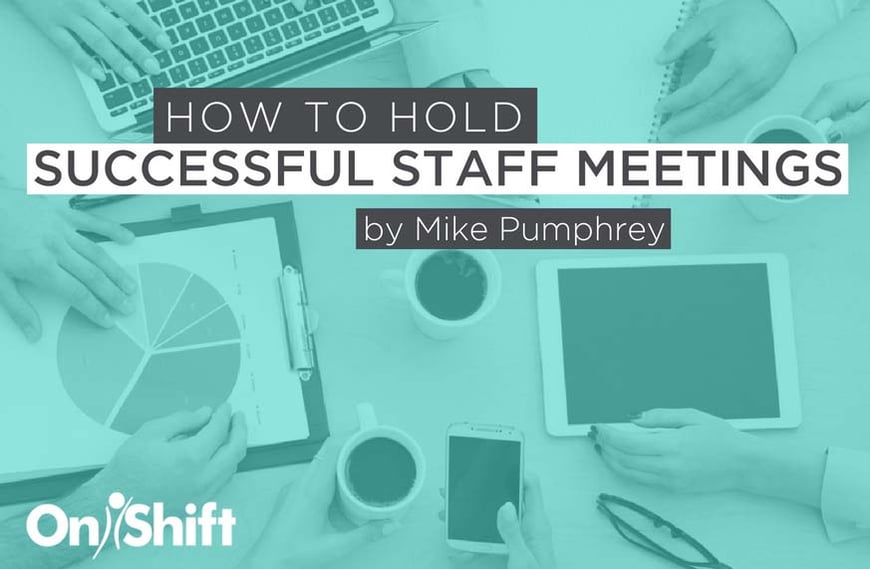June 4, 2018 | Mike Pumphrey
June 4, 2018 | Mike Pumphrey
 Every employee, from hourly workers to c-suite executives, has sat through some bad meetings. However, when run well, meetings can bring teams closer, get everyone on the same page, solve problems and even inspire ideas.
Every employee, from hourly workers to c-suite executives, has sat through some bad meetings. However, when run well, meetings can bring teams closer, get everyone on the same page, solve problems and even inspire ideas.
No matter the topic or team leader, here are six proven tactics for holding successful, productive meetings in senior care settings.
1. Set The Agenda
One major meeting failure is not having a concrete agenda. An agenda provides guidance for the meeting, whether it’s a quick 10-minute touch base or one that lasts all day. Without an agenda, attendees won’t have a sense of direction and the meeting is less likely to accomplish its goals.
Agendas should include important points the meeting will touch on, as well as the order in which they will be discussed. Also, try to send out the meeting invitations a few days in advance. Everyone has busy schedules, so it helps to know a meeting is days away, not minutes away. Providing advanced notice also helps boost participation, as attendees will be better able to structure their schedules in order to attend.
Sending out invites early also lets attendees review the agenda and properly prepare for the meeting.
2. Designate A Moderator
Put someone in charge of sticking to the agenda. Often times, many to-discuss items don't get addressed because too much time is spent on one topic.
A moderator can move the meeting along to ensure that you cover everything. This person can also assign action items to people in the meeting like setting up follow-up meetings for topics that need further discussion. Some companies even give their moderators a timer and allot only a specific amount of time to discuss each agenda item to keep the meeting on track.
3. Invite The Right People
Meeting organizers should only invite the people who are necessary for the items being discussed. If the goal of the meeting is to discuss an issue where a decision must be made, it's important to have the key stakeholders involved.
There’s no greater waste of time than being in a meeting where the necessary decision makers aren’t there. By setting a meeting agenda in advance, organizers can determine who needs to be present. Take inspiration from Amazon CEO Jeff Bezos, who likes to keep meetings small enough that everyone in attendance can be fed with a total of two large pizzas.
4. Start On Time
It sounds simple, but when a meeting is scheduled to start at noon, it should start at noon. When the invite says it’s going to end at 12:30 P.M., it needs to end at 12:30 P.M.
Time management is a critical component to more successful meetings. Again, people are busy; time is valuable. No one wants to sit around waiting for a meeting to start. Similarly, enacting a hard stop keeps the meeting on track, per the agenda. The longer a meeting drags on, the more likely attendees are to lose interest. If you need to more time, set up a follow-up meeting on a later date when all necessary attendees are available.
5. Take Notes & Distribute
A productive meeting and important questions can be lost in the abyss if attendees don’t take notes. This is another duty that can be assigned to your moderator.
Attendees can’t be forced to take notes, but it’s best practice to do so, especially if discussion points need to be referenced at a later time. While digital devices are popular note-keeping tools, try to attend future meetings with a notebook to limit distractions caused by emails, chats and other notifications.
Taking notes may also come in handy if someone can’t attend the meeting. The organizer can send out a recap to ensure everyone knows the key takeaways, action items and next steps once a meeting concludes.
6. Make Employees Part Of The Process
Often times, meetings are dominated by management’s and other higher ups’ agenda. Be sure to let employees suggest topics for discussion during team meetings. Frequent pulse surveys with the ability to leave feedback are a great way to uncover any issues or employee suggestions for process improvements. Meeting stakeholders can take the information collected and open the topics up for discussion.
Making employees part of the process and giving them a voice for positive change boosts engagement and improves your organizational culture.
Successful meetings don’t happen by accident — they are planned in advance with set agendas and solid time management. Following the above tips will help all senior care employees and executives make their meetings more successful.
Subscribe to the OnShift Blog
Recent Posts
Categories
About Mike Pumphrey
Mike Pumphrey is Vice President of Product Marketing at OnShift. His expertise in staffing and labor management strategies in long-term care and senior living is foundational to his role leading OnShift’s Product Marketing team. Mike works hand-in-hand with state and national associations, senior care providers, and with OnShift’s Customer Success and Product teams to create impactful best practices aimed to help solve the daily workforce challenges in senior care. Mike shares insights, research and recommendations to improve clinical, operational, and financial outcomes through regular blog posts and conference speaking engagements.
See for yourself why thousands of providers rely on OnShift’s innovative software for recruitment, hiring, workforce management, pay and engagement. Request your personalized demo today.
